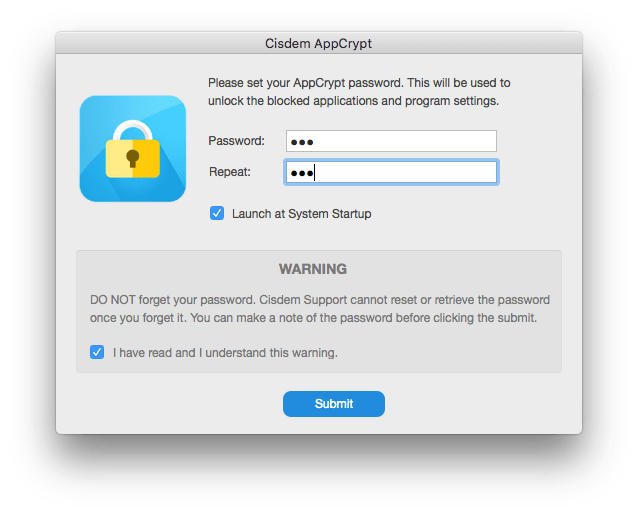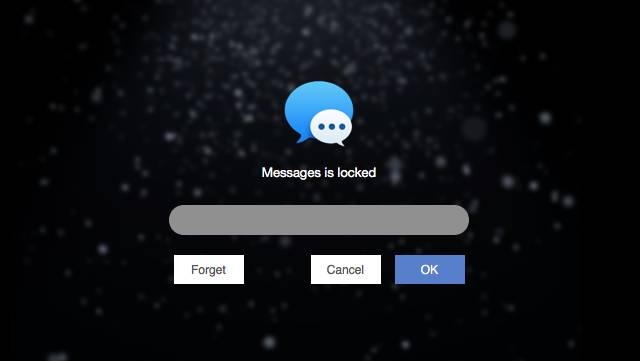Password Protect Apps on Mac: Lock iMessage and Others
 72.2K
72.2K
 7
7
“Is there a way to password protect the Messages app on my MacBook? My kid sometimes uses my Mac, and I don’t want them accessing my messages.”
How to lock iMessage on Mac with password? This article walk you through how to lock Messages app on your Macbook, iMac, MacBook Air or MacBook Pro with password, how to auto lock Messages after it’s not active or after you leave your Mac, how to stop Messages notifications on Mac, etc. to protect your privacy.
 Cisdem AppCrypt
Cisdem AppCrypt
The Best Messages Locker for Mac
- Password lock any Mac apps such as Messages, Photos, Evernote, etc.
- Record failed attempts to open locked apps, offering date, time and the photo of intruder
- Offer an option to automatically relock an app after it’s inactive for a while
- Also let you lock all apps on Mac except approved ones
- Block specific websites or categories of websites with password
- Offer a Schedule feature to lock apps and block sites during certain times
- Easy to use
- Hard to bypass
- Require password to enter/quit/uninstall AppCrypt
- Help guard privacy by protecting your apps
- Can be used for privacy protection, productivity, parental control, etc.
- Support macOS 10.12 or later
- Also available for Windows, iPhone and iPad, and Android
How to password protect iMessage and other apps on Mac
How to lock apps on MacBook Air, MacBook Pro and other Mac computers easily with password? This part will walk you through the entire process of putting a password on iMessage on Mac. The tool used is Cisdem AppCrypt, an app locker and website blocker.
Steps: How to lock Messages on MacBook, iMac, etc.
1. Download and install this Mac app locker.
2. When you open it for the first time, set a password according to the prompts.

3. Click its icon in the menu bar. Choose Open Main Window.

4. Enter the password. Now you are in the main window. Under the App Lock tab, click the plus icon  .
.

5. To lock iMessage on Mac, select the Messages app and click Open.

Now the Messages app is locked by password. People with access to your Mac can’t access the app and messages in it. It’s that easy and effective. You can follow the steps to lock any other built-in apps or third-party apps on your Mac, individually or in bulk. In the fifth step, you can select multiple apps to lock.
When you or anyone else tries to open the locked Messages app, a window will show up asking for password. No password? No access.

If someone tries to launch iMessage or any apps protected by AppCrypt and enters a wrong password, it won’t open. The tool will also record the failed attempt with time and date and take a photo of the person who tries to break in.

Entering the correct password will unlock the locked app. To remove the lock from an app, select the app and press the delete key.
Tips
Enable the Auto Lock for iMessage This tool offers a feature to automatically relock iMessage or any other locked app after it’s not active for several minutes or after you leave your Mac for several minutes. You can turn on this feature in AppCrypt Preferences. Check the 2 boxes under App Lock. Set your desired auto lock time. By the way, it’s recommended to turn on “Launch at system startup”.

Lock iMessage or certain apps at certain times You lock Messages with password to protect privacy. You may also want to lock certain apps like game apps to prevent yourself or your child from spending too much time on them. If so, you can use the Schedule feature. Select an app and click the clock icon that appears. Enable Custom Schedule and click Add Schedule.


A note from our experts:
To protect your iMessage privacy, locking the Messages app on Mac may be not enough. If you use iCloud sync, your iMessage will still be accessible on other connected Apple devices. The good news is that Cisdem AppCrypt is also available on iOS and free to use, allowing you to lock Messages across your devices.
Bonus tips to help better protect iMessage on Mac
How to block access to Messages by locking the screen of your Mac
To keep the iMessage messages and other information on your Mac private and secure when you are away, you can lock the screen. There are two things that you can do.
Before you leave your Mac, go to the Apple menu and choose the Lock Screen option.
Also, set your Mac to require a password when it wakes from sleep.
1. Click the Apple menu. Go to System Settings.

2. Choose Lock Screen from the left menu.
3. Click the pop-up menu next to the Require password after screen saver begins or display is turned off option and choose a period of time such as immediately or 1 minute.

This way, your Mac is locked and protected, so are the Messages app and all other stuffs on your Mac.
If locking Mac’s screen isn’t practical to you, the best solution is to lock the Messages app.
How to stop iMessage on Mac from popping up
You choose to password protect iMessage on Mac for the sake of privacy. Once apps are password protected on Mac, other people won’t be able to open them or access the content within. It’s a good decision to take.
Another way to stop the exposure of privacy is to stop notifications. Notifications are a great way to always keep you informed. However, imagine that an embarrassing iMessage notification pops up when you are giving an important presentation or sharing screen during an online meeting. How to prevent iMessage from popping up on Mac? Follow the steps below.
1. On your Mac, open System Settings through the Apple Menu.
2. Click Notifications.
3. Scroll down until you find Messages. Select it.

4. Under the Messages alert style section, choose None.

From now on, nothing will pop up when you receive messages. You can easily get notifications back at any time if you want to.
How do I sign out of iMessage on Mac when I no longer using it?
If you enabled Messages in iCloud on both your Mac and other devices like your iPhone, then the messages you send or receive on your iPhone will also be synced with your Mac. When you lend your Mac to other users and do not lock the Messages app, they can easily access it and invade your privacy. In this case, you can sign out of your iMessages account on Mac.
1. Open the Messages app on your Mac.
2. Open the Messages menu. Click Preferences.
3. Go to the Accounts tab.
4. Choose iMessage from the left sidebar.
5. Click Sign Out.
The next time you want to access it, it will ask you to enter your Apple ID and password.
Conclusion
Can you put a password on iMessage on Mac? Yes. It’s also easy to password protect any other apps on a Mac computer. Tools like AppCrypt can help you effectively prevent other people from opening your apps when you are away from your Mac or lend it to others. Of course, you can set login password to completely block access to your computer, but it’s not applicable to some situations.
Check out the detailed guides to password locking other specific Mac apps.

Norah Hayes likes to share her tips on how to improve focus and stay motivated at work. She believes it is essential to eliminate all online distractions during work hours.

Ethan Long joined Cisdem in 2015 as a developer and now serves as the editorial advisor for Cisdem AppCrypt. He actively tests and uses Cisdem AppCrypt and other screen-time management tools to ensure AppCrypt meets its promises in real-world scenarios.
















 Free Download
Free Download
Random Michael
From what you write, AppCrypt seems a great app to lock apps. I'm also interested in the site blocking feature. I'll definitely try it out.
Timothy
I like this app very much. Now I can feel free to lend my Mac to friends. It is a trustworthy app , using it from a quite long time.
Bers Khamitov
Hi Rosa, I am quite interested in this program. But I have a question: How does it keep records of the failed attempts?
Rosa Reyes
When someone tries to access your password protected application, AppCrypt will ask he or she to enter a password. If the password is wrong, system will keep a record automatically with photo, time and reason.
Kelsey
I know there are some paid apps can add password protection to individual applications, but are there any free ways to do that?
Rosa Reyes
As far as I know, there are no free ways to password protection individual applications. But you can use Mac's built-in Parental Control to set restriction on some apps.
Wayne
Password protecting individual applications is very helpful to protect my sensitive information from prying eyes. I love this app. Thanks for suggesting.